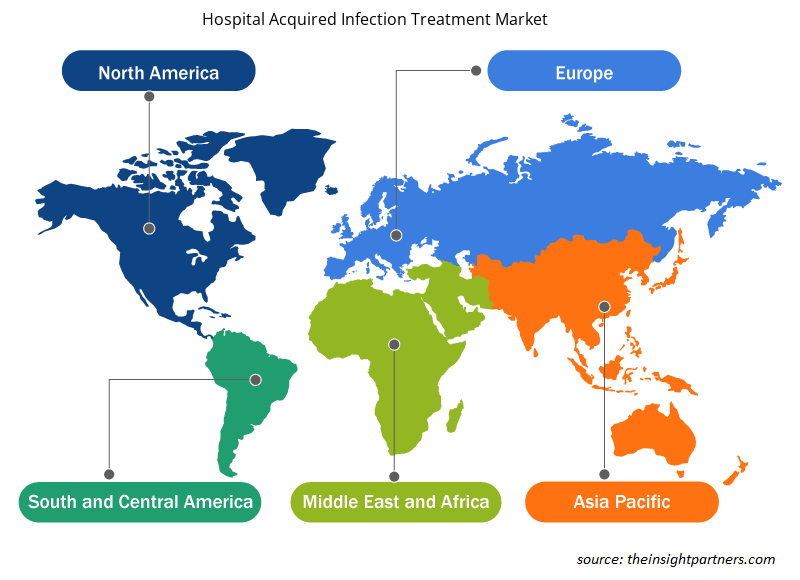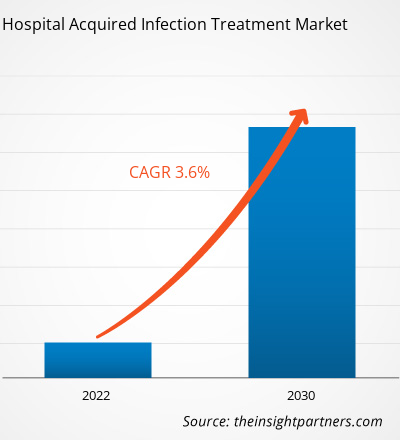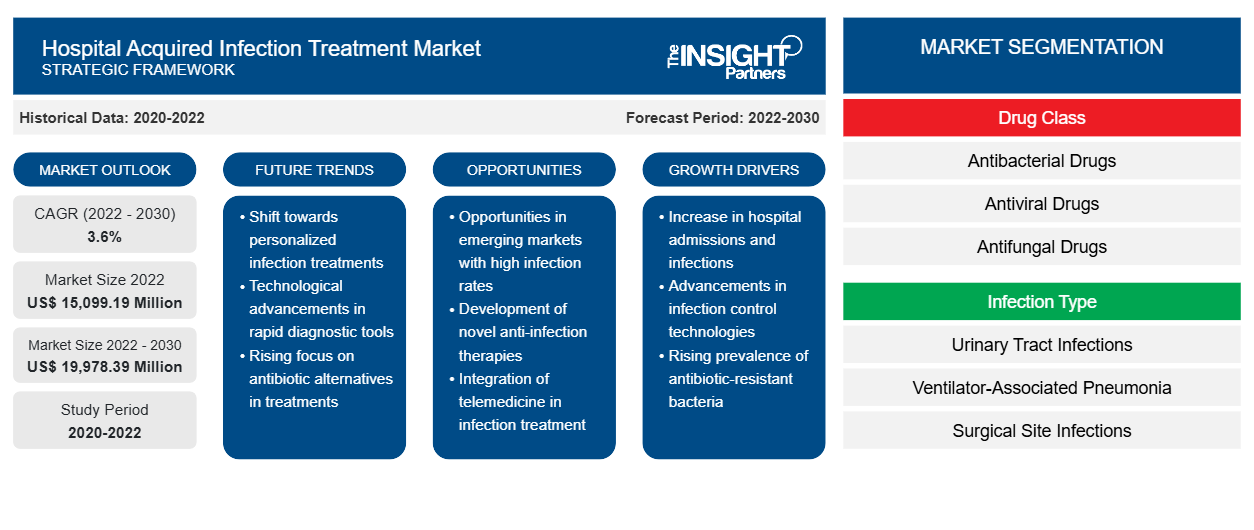[تقرير بحثي] من المتوقع أن ينمو سوق علاج العدوى المكتسبة من المستشفيات من 15،099.19 مليون دولار أمريكي في عام 2022 إلى 19،978.39 مليون دولار أمريكي بحلول عام 2030؛ ومن المتوقع أن يسجل معدل نمو سنوي مركب بنسبة 3.6٪ من عام 2022 إلى عام 2030.
رؤى السوق ووجهة نظر المحلل:
قد تتطور العدوى المكتسبة من المستشفيات (HAIs)، والمعروفة أيضًا باسم العدوى المكتسبة من المستشفيات، في مجموعة متنوعة من البيئات، بما في ذلك المستشفيات ومؤسسات الرعاية طويلة الأجل والبيئات الخارجية، ويمكن أن تظهر أيضًا بعد الخروج من المستشفى. يمكن أن تنطوي العدوى المكتسبة من المستشفيات أيضًا على عدوى مهنية تؤثر على العاملين في مجال الرعاية الصحية. العوامل الرئيسية التي تدفع نمو سوق علاج العدوى المكتسبة من المستشفيات هي ارتفاع معدل انتشار العدوى المكتسبة من المستشفيات والتركيز المتزايد على سلامة المرضى وجودة الرعاية. ومع ذلك، فإن تهديد مقاومة مضادات الميكروبات يعيق نمو سوق علاج العدوى المكتسبة من المستشفيات .
محركات النمو ومعوقاته:
تعد عدوى مجرى الدم المرتبطة بالقسطرة المركزية، والتهابات المسالك البولية المرتبطة بالقسطرة، والالتهاب الرئوي المرتبط بأجهزة التنفس الصناعي من الأمثلة القليلة على العدوى المرتبطة بالرعاية الصحية. يمكن أن تنشأ هذه العدوى، المعروفة باسم عدوى موقع الجراحة، أيضًا في مواقع الجراحة. وفقًا لتقرير مراكز السيطرة على الأمراض والوقاية منها "تقرير التقدم الوطني والولائي للعدوى المرتبطة بالرعاية الصحية لعام 2020" المنشور في عام 2021، زادت حالات عدوى مجرى الدم المرتبطة بالقسطرة المركزية، وبكتيريا المكورات العنقودية الذهبية المقاومة للميثيسيلين (MRSA)، والأحداث المرتبطة بأجهزة التنفس الصناعي بنسبة 24٪ و35٪ و15٪ على التوالي، في الولايات المتحدة بين عامي 2019 و2020.
علاوة على ذلك، وفقًا لتقرير يناير 2022 الصادر عن الشبكة الوطنية لسلامة الرعاية الصحية (NHSN)، فإن التهابات المسالك البولية هي خامس أكثر أنواع العدوى المرتبطة بالرعاية الصحية شيوعًا. تمثل التهابات المسالك البولية أكثر من 9.5٪ من حالات المستشفيات للرعاية الحادة. تحدث عدوى المسالك البولية المرتبطة بالقسطرة (CAUTI) بسبب القسطرة البولية المستخدمة لتصريف البول من المثانة. تعد عدوى المسالك البولية المرتبطة بالقسطرة واحدة من أكثر أنواع العدوى شيوعًا بين مرضى التهابات المسالك البولية في المستشفيات. وفقًا لمراكز السيطرة على الأمراض والوقاية منها (CDC)، فإن ما يقرب من 75٪ من العدوى مرتبطة بقسطرة بولية. أثناء إقامتهم في المستشفى، يحتاج 15٪ إلى 25٪ من المرضى في المستشفى إلى استخدام قسطرة بولية. يعد استخدام قسطرة البول لفترة طويلة هو عامل الخطر الرئيسي للإصابة بعدوى المسالك البولية المرتبطة بالقسطرة. تتضمن مضاعفات عدوى المسالك البولية المرتبطة بالقسطرة معاناة المريض، وإطالة فترة إقامته في المستشفى، وزيادة تكاليف العلاج، وحتى الموت.
علاوة على ذلك، وفقًا لمراكز السيطرة على الأمراض والوقاية منها، فإن التهابات المسالك البولية مسؤولة عن أكثر من 13000 حالة وفاة كل عام. يسبب التهاب المثانة الحاد غير المعقد حوالي ستة أيام من الانزعاج، مما يؤدي إلى حوالي 7 ملايين زيارة مكتبية كل عام بتكلفة 1.6 مليار دولار أمريكي. ونتيجة لذلك، يفرض العدد المتزايد من حالات العدوى المرتبطة بالرعاية الصحية عبئًا ماليًا كبيرًا على نظام الرعاية الصحية. إن الانتشار المتزايد لالتهاب المسالك البولية المرتبط بالرعاية، إلى جانب الطلب المتزايد على الأدوية للعلاج، يدفع السوق إلى الأمام.
ومع ذلك، تشكل مقاومة مضادات الميكروبات تحديًا كبيرًا لعلاج العدوى المرتبطة بالرعاية الصحية، مما يحد من فعالية العوامل المضادة للميكروبات الموجودة ويستلزم تطوير استراتيجيات علاجية جديدة وبدائل مضادة للميكروبات لمكافحة مسببات الأمراض المقاومة بشكل فعال.
قم بتخصيص هذا التقرير ليناسب متطلباتك
ستحصل على تخصيص لأي تقرير - مجانًا - بما في ذلك أجزاء من هذا التقرير، أو تحليل على مستوى الدولة، وحزمة بيانات Excel، بالإضافة إلى الاستفادة من العروض والخصومات الرائعة للشركات الناشئة والجامعات
-
احصل على أهم اتجاهات السوق الرئيسية لهذا التقرير.ستتضمن هذه العينة المجانية تحليلاً للبيانات، بدءًا من اتجاهات السوق وحتى التقديرات والتوقعات.
تقسيم التقرير ونطاقه:
يتم تقسيم سوق علاج العدوى المكتسبة في المستشفيات العالمية على أساس فئة الدواء ونوع العدوى وقناة التوزيع. بناءً على فئة الدواء، يتم تقسيم سوق علاج العدوى المكتسبة في المستشفيات إلى أدوية مضادة للبكتيريا وأدوية مضادة للفيروسات وأدوية مضادة للفطريات وغيرها. بناءً على نوع العدوى، يتم التمييز بين علاج العدوى المكتسبة في المستشفيات إلى التهابات المسالك البولية والالتهاب الرئوي المرتبط بجهاز التنفس الصناعي والتهابات موقع الجراحة والتهابات مجرى الدم وغيرها من التهابات المستشفيات. بناءً على قناة التوزيع، يتم تقسيم السوق إلى صيدليات المستشفيات وصيدليات التجزئة والتجارة الإلكترونية وغيرها. يتم تقسيم سوق علاج العدوى المكتسبة من المستشفيات، على أساس الجغرافيا، إلى أمريكا الشمالية (الولايات المتحدة وكندا والمكسيك)، وأوروبا (ألمانيا وفرنسا وإيطاليا والمملكة المتحدة وروسيا وبقية أوروبا)، وآسيا والمحيط الهادئ (أستراليا والصين واليابان والهند وكوريا الجنوبية وبقية آسيا والمحيط الهادئ)، والشرق الأوسط وأفريقيا (جنوب أفريقيا والمملكة العربية السعودية والإمارات العربية المتحدة وبقية الشرق الأوسط وأفريقيا)، وأمريكا الجنوبية والوسطى (البرازيل والأرجنتين وبقية أمريكا الجنوبية والوسطى).
التحليل القطاعي:
ينقسم سوق علاج العدوى المكتسبة من المستشفيات، حسب فئة الدواء، إلى أدوية مضادة للبكتيريا وأدوية مضادة للفيروسات وأدوية مضادة للفطريات وغيرها. احتل قطاع الأدوية المضادة للبكتيريا الحصة الأكبر في السوق في عام 2022 ومن المتوقع أن يسجل أعلى معدل نمو سنوي مركب خلال الفترة 2022-2030.
ينقسم سوق علاج العدوى المكتسبة من المستشفيات، حسب نوع العدوى، إلى التهابات المسالك البولية ، والالتهاب الرئوي المرتبط بأجهزة التنفس الصناعي، والتهابات موقع الجراحة، والتهابات مجرى الدم، والتهابات المستشفيات الأخرى. احتل قطاع التهابات المسالك البولية أكبر حصة سوقية في عام 2022. ومع ذلك، من المتوقع أن يسجل قطاع الالتهاب الرئوي المرتبط بأجهزة التنفس الصناعي أعلى معدل نمو سنوي مركب من عام 2022 إلى عام 2030.
ينقسم سوق علاج العدوى المكتسبة من المستشفيات، حسب قناة التوزيع، إلى صيدليات المستشفيات وصيدليات التجزئة والتجارة الإلكترونية وغيرها. في عام 2022، استحوذ قطاع صيدليات المستشفيات على أكبر حصة في السوق، ومن المتوقع أن يسجل نفس القطاع أعلى معدل نمو سنوي مركب خلال الفترة 2022-2030.
التحليل الإقليمي:
على أساس الجغرافيا، يتم تقسيم سوق علاج العدوى المكتسبة من المستشفيات العالمية إلى خمس مناطق رئيسية هي أمريكا الشمالية وأوروبا وآسيا والمحيط الهادئ وأمريكا الجنوبية والوسطى والشرق الأوسط وأفريقيا.
في عام 2022، استحوذت أمريكا الشمالية على أكبر حصة من حجم سوق علاج العدوى المكتسبة في المستشفيات على مستوى العالم. وتتمتع الولايات المتحدة بمعدل انتشار مرتفع للعدوى المرتبطة بالرعاية الصحية، مما يدفع سوق علاج العدوى المكتسبة في المستشفيات إلى النمو. ووفقًا لمراكز السيطرة على الأمراض والوقاية منها، في أي يوم، يعاني حوالي 1 من كل 31 مريضًا في المستشفى من عدوى مرتبطة بالرعاية الصحية على الأقل. وبالمثل، وفقًا لمكتب الوقاية من الأمراض وتعزيز الصحة، يمكن أن تؤدي العدوى المرتبطة بالرعاية الصحية والالتهابات الأخرى إلى تعفن الدم، وتسبب حوالي 1.7 مليون حالة مرضية و270 ألف حالة وفاة سنويًا في الولايات المتحدة. وبالتالي، فإن الانتشار المرتفع للعدوى المرتبطة بالرعاية الصحية بين الأشخاص في الولايات المتحدة يغذي نمو سوق علاج العدوى المكتسبة في المستشفيات.
تطورات الصناعة والفرص المستقبلية:
فيما يلي قائمة بالمبادرات المختلفة التي اتخذها اللاعبون الرئيسيون العاملون في سوق علاج العدوى المكتسبة من المستشفيات العالمية:
- في مايو 2023، أعلنت شركة Innoviva Specialty Therapeutics أن إدارة الغذاء والدواء الأمريكية (FDA) وافقت على XACDURO (سولباكتام للحقن؛ دورلوباكتام للحقن)، المعبأ للاستخدام الوريدي في المرضى الذين تبلغ أعمارهم 18 عامًا أو أكثر لعلاج الالتهاب الرئوي الجرثومي المكتسب من المستشفى والالتهاب الرئوي الجرثومي المرتبط بجهاز التنفس الصناعي (HABP/VABP) الناجم عن عزلات حساسة من مجمع Acinetobacter baumannii-calcoaceticus (Acinetobacter). ذكرت شركة Innoviva Specialty Therapeutics أنها تركز على تقديم علاجات مبتكرة في الرعاية الحرجة والأمراض المعدية.
- في مايو 2023، أعلن باحثون من المعهد الهندي لتعليم العلوم والبحث (IISER)، في بوني ومعهد أبحاث الأدوية المركزي (CSIR-CDRI)، لكناو أنهم اكتشفوا مضادًا حيويًا جديدًا محتملاً ضد Acinetobacter baumannii، والذي يسبب بشكل متكرر العدوى المرتبطة بالرعاية الصحية.
- في سبتمبر 2020، أعلنت شركة Shionogi & Co Ltd أن إدارة الغذاء والدواء قد وافقت على طلب دواء جديد تكميلي (sNDA) لـ FETROJA (cefiderocol) لعلاج المرضى الذين تبلغ أعمارهم 18 عامًا أو أكثر والذين يعانون من الالتهاب الرئوي الجرثومي المكتسب من المستشفى والالتهاب الرئوي الجرثومي المرتبط بجهاز التنفس الصناعي (HABP / VABP) الناجم عن الكائنات الحية الدقيقة سلبية الجرام الحساسة مثل مجمع Enterobacter cloacae، Klebsiella pneumoniae، مجمع Acinetobacter baumannii، Escherichia coli، Pseudomonas aeruginosa، و Serratia marcescens.
- في يونيو 2020، أعلنت شركة ميرك أن إدارة الغذاء والدواء الأمريكية (FDA) قد وافقت على طلب دواء جديد تكميلي (sNDA) لـ RECARBRIO (إيميبينيم وسيلاستاتين وريليبكتام) لعلاج المرضى الذين تبلغ أعمارهم 18 عامًا أو أكثر والذين يعانون من الالتهاب الرئوي الجرثومي المكتسب من المستشفى والالتهاب الرئوي الجرثومي المرتبط بجهاز التنفس الصناعي (HABP / VABP)، الناجم عن الكائنات الحية الدقيقة سلبية الجرام الحساسة مثل مجمع Acinetobacter calcoaceticus-baumannii، Klebsiella oxytoca، Klebsiella pneumoniae، Enterobacter cloacae، Escherichia coli، Haemophilus influenzae، Klebsiella aerogenes، Pseudomonas aeruginosa، و Serratia marcescens.
رؤى إقليمية حول سوق علاج العدوى المكتسبة من المستشفيات
لقد قام المحللون في Insight Partners بشرح الاتجاهات والعوامل الإقليمية المؤثرة على سوق علاج العدوى المكتسبة من المستشفيات طوال فترة التوقعات بشكل شامل. يناقش هذا القسم أيضًا قطاعات سوق علاج العدوى المكتسبة من المستشفيات والجغرافيا في جميع أنحاء أمريكا الشمالية وأوروبا ومنطقة آسيا والمحيط الهادئ والشرق الأوسط وأفريقيا وأمريكا الجنوبية والوسطى.

- احصل على البيانات الإقليمية المحددة لسوق علاج العدوى المكتسبة في المستشفيات
نطاق تقرير سوق علاج العدوى المكتسبة من المستشفيات
| سمة التقرير | تفاصيل |
|---|---|
| حجم السوق في عام 2022 | 15,099.19 مليون دولار أمريكي |
| حجم السوق بحلول عام 2030 | 19,978.39 مليون دولار أمريكي |
| معدل النمو السنوي المركب العالمي (2022 - 2030) | 3.6% |
| البيانات التاريخية | 2020-2022 |
| فترة التنبؤ | 2022-2030 |
| القطاعات المغطاة |
حسب فئة الدواء
|
| المناطق والدول المغطاة |
أمريكا الشمالية
|
| قادة السوق وملفات تعريف الشركات الرئيسية |
|
كثافة اللاعبين في سوق علاج العدوى المكتسبة من المستشفيات: فهم تأثيرها على ديناميكيات الأعمال
يشهد سوق علاج العدوى المكتسبة من المستشفيات نموًا سريعًا، مدفوعًا بالطلب المتزايد من المستخدم النهائي بسبب عوامل مثل تفضيلات المستهلكين المتطورة والتقدم التكنولوجي والوعي المتزايد بفوائد المنتج. ومع ارتفاع الطلب، تعمل الشركات على توسيع عروضها والابتكار لتلبية احتياجات المستهلكين والاستفادة من الاتجاهات الناشئة، مما يؤدي إلى زيادة نمو السوق.
تشير كثافة اللاعبين في السوق إلى توزيع الشركات أو المؤسسات العاملة في سوق أو صناعة معينة. وهي تشير إلى عدد المنافسين (اللاعبين في السوق) الموجودين في مساحة سوق معينة نسبة إلى حجمها أو قيمتها السوقية الإجمالية.
الشركات الرئيسية العاملة في سوق علاج العدوى المكتسبة من المستشفيات هي:
- شركة ميرك آند كو
- شركة فايزر
- شركة آبفي
- شركة باراتيك للادوية
- يوجيا الولايات المتحدة المحدودة
إخلاء المسؤولية : الشركات المذكورة أعلاه ليست مرتبة بأي ترتيب معين.

- احصل على نظرة عامة على أهم اللاعبين الرئيسيين في سوق علاج العدوى المكتسبة من المستشفيات
المنافسة والشركات الرئيسية:
تعد Merck & Co Inc وPfizer Inc وAbbVie Inc وParatek Pharmaceuticals Inc وEugia US LLC وAbbott Laboratories وCumberland Pharmaceuticals Inc وInnoviva Specialty Therapeutics Inc وCipla Ltd وEli Lilly and Company من بين اللاعبين البارزين الذين يعملون في سوق علاج العدوى المكتسبة من المستشفيات. تركز هذه الشركات على التقنيات الجديدة والتقدم في المنتجات الحالية والتوسع الجغرافي لتلبية الطلب المتزايد من المستهلكين في جميع أنحاء العالم وزيادة نطاق منتجاتها في محافظ التخصصات.
- التحليل التاريخي (سنتان)، سنة الأساس، التوقعات (7 سنوات) مع معدل النمو السنوي المركب
- تحليل PEST و SWOT
- حجم السوق والقيمة / الحجم - عالمي، إقليمي، بلد
- الصناعة والمنافسة
- مجموعة بيانات إكسل
التقارير الحديثة
تقارير ذات صلة
شهادات العملاء
سبب الشراء
- اتخاذ قرارات مدروسة
- فهم ديناميكيات السوق
- تحليل المنافسة
- رؤى العملاء
- توقعات السوق
- تخفيف المخاطر
- التخطيط الاستراتيجي
- مبررات الاستثمار
- تحديد الأسواق الناشئة
- تحسين استراتيجيات التسويق
- تعزيز الكفاءة التشغيلية
- مواكبة التوجهات التنظيمية























 احصل على عينة مجانية ل - سوق علاج العدوى المكتسبة من المستشفيات
احصل على عينة مجانية ل - سوق علاج العدوى المكتسبة من المستشفيات